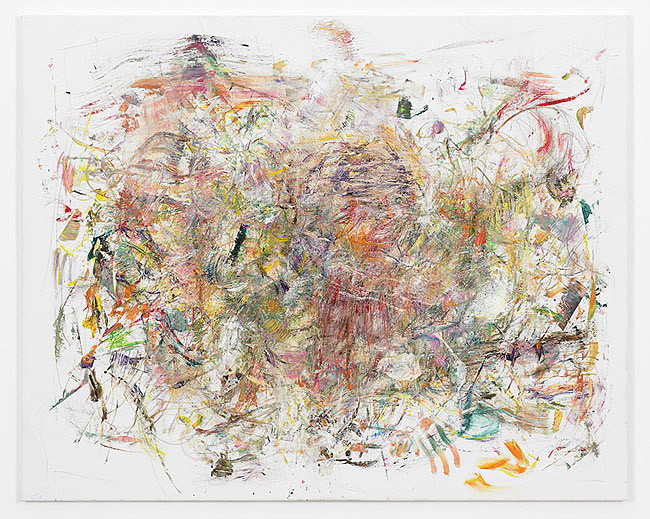Matthias Schaufler
12 Apr - 09 Jun 2012
MATTHIAS SCHAUFLER
Imkerin
12 April – 9 June, 2012
Gallery Weekend
27 - 29 April 2012
In his third solo exhibition at Galerie Cinzia Friedlaender, Matthias Schaufler further investigates the limits of the medium of painting. At the core of Schaufler’s abstractions lies a resonant apparition, a vivid phantasm of a figurative nature: a body, a specter of the traditional nude, serves as the central point of reference as well as a catalyst for the underlying query.
The female nude – painting’s most traditional motif and possibly a painter’s most rudimentary formal interrogation – is evoked in Schaufler’s new series of paintings within a metaphysical setting of a dialogue with nature. However, clad in a protective suit, the beekeeper is sealed off from the luscious garden, which is dripping with color and buzzing with light.
The materiality of the body in nature and the fact of its quarantine-like presence within it both point towards a dissonance, a protective yet confining alienation. The dialogue thus includes its own interruption, while the barrier in communication is suggestive of a disorder, a speech impeachment, possibly a struggle.
Schaufler, who refers to his handling of the medium as a form of confrontation, undertakes a painterly struggle with the aforementioned specter of a female nude, while making use of nearly every technical means available to a painter. As such, the interrogation enters the realm of a physical undertaking, alongside a conceptual one, in which every brush stroke, enhanced by scratches and finger paintings on the canvas mark the tangible traces of a corporeal endeavor.
Doubt is at the core of the gesture. It is the overcoming of the unsettled instinct that imbues the artwork with purpose, and motivates its inherent ambition of abandoning the ego to let abstraction take over. The artist explores the formal boundaries of what makes a beautiful painting, bringing it almost to the point of no return, only to fulfill the ambition of aesthetic salvation. When intention, volition or control are finally dropped, that’s where painting begins.
Text: Hili Perlson
Imkerin
12 April – 9 June, 2012
Gallery Weekend
27 - 29 April 2012
In his third solo exhibition at Galerie Cinzia Friedlaender, Matthias Schaufler further investigates the limits of the medium of painting. At the core of Schaufler’s abstractions lies a resonant apparition, a vivid phantasm of a figurative nature: a body, a specter of the traditional nude, serves as the central point of reference as well as a catalyst for the underlying query.
The female nude – painting’s most traditional motif and possibly a painter’s most rudimentary formal interrogation – is evoked in Schaufler’s new series of paintings within a metaphysical setting of a dialogue with nature. However, clad in a protective suit, the beekeeper is sealed off from the luscious garden, which is dripping with color and buzzing with light.
The materiality of the body in nature and the fact of its quarantine-like presence within it both point towards a dissonance, a protective yet confining alienation. The dialogue thus includes its own interruption, while the barrier in communication is suggestive of a disorder, a speech impeachment, possibly a struggle.
Schaufler, who refers to his handling of the medium as a form of confrontation, undertakes a painterly struggle with the aforementioned specter of a female nude, while making use of nearly every technical means available to a painter. As such, the interrogation enters the realm of a physical undertaking, alongside a conceptual one, in which every brush stroke, enhanced by scratches and finger paintings on the canvas mark the tangible traces of a corporeal endeavor.
Doubt is at the core of the gesture. It is the overcoming of the unsettled instinct that imbues the artwork with purpose, and motivates its inherent ambition of abandoning the ego to let abstraction take over. The artist explores the formal boundaries of what makes a beautiful painting, bringing it almost to the point of no return, only to fulfill the ambition of aesthetic salvation. When intention, volition or control are finally dropped, that’s where painting begins.
Text: Hili Perlson

